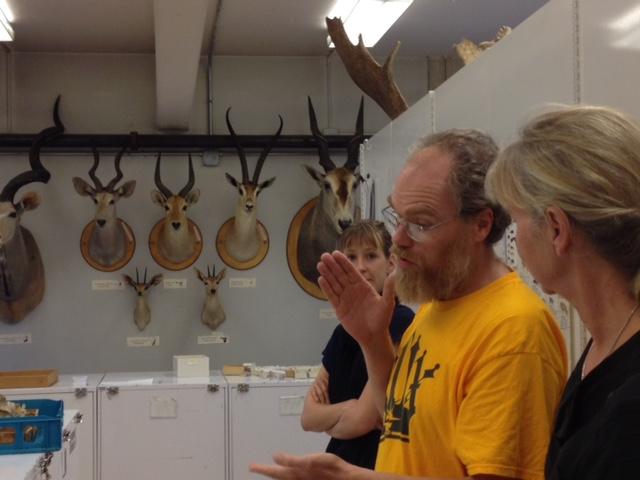At Large In Ballard: Special Delivery
Mammalogy Collection Manager and staff with Helle Andersen (right).
Wed, 09/21/2016
By Peggy Sturdivant
My friend Helle Andersen had rescued a donated, dead, green sea turtle from the Feiro Marine Life Center’s freezer in Port Angeles and was delivering it to the Dermestidae room at the Burke Museum. She knew I’d want to ride along. The turtle was going there to be cleaned by flesh-eating beetles (the Dermestidae).
Given what’s inside the Burke Museum you wouldn’t have thought producing a large sea turtle wrapped in plastic from the back of a car would draw a crowd. But it was lunch hour and staff watching the dig for the “New Burke,” in true archeological fashion, were very excited because the cement had finally been poured. (Or maybe they wear real cameras hung around their necks every day).
The turtle had frozen into a semblance of life since it was found three years ago in Gray’s Harbor and then necropsied by U.S. Fish & Wildlife. Its head was poking alertly out of its carapace, a bit cocked as though to better study those gathered round, until you realized the eyes weren’t just hooded, they were gone. “If you don’t mind giving me a hand,” Mammalogy Collection Manager Jeffrey Bradley said, “We’ll take this up to the lab.”
Mind? I trailed them up the loading dock through the door to the inner sanctum. It’s what I love best about my life “At Large,” going behind the door marked staff, to the rooftop with Asher Deaver, into the culverts of the big Lock. It’s accompanying Helle Andersen, Jeff Bradley and a 91cm reptile to the mammal dissection room.
Andersen is the Citizen Science Coordinator at Feiro. The U.S. Fish & Wildlife Service had given the turtle to Feiro years ago; it had gotten somewhat buried. No one really knew what to do with the turtle. Andersen made some calls and connected with Bradley at the Burke, officially the Washington State Museum of Natural History & Culture. He said they’d be happy to clean the turtle.
I imagined a big dishwasher-like machine with special jets. Yes, she said she was taking the turtle to the museum’s beetle farm, but I assumed they also cleaned very large beetles. I did not have a clue we were delivering a protected green sea turtle to be eaten to the bones by hungry beetles and their larvae.
The turtle needed to thaw. Amid mounted birds, a pangolin (resembles scaled anteater), and a river otter without skin, the green sea turtle still got celebrity treatment. This species is more common in tropical and sub-tropical waters, and has been prized for its meat while named for its green fat. This turtle’s condition and its documentation made it exceptional. The staff exclaimed over its long fins and intact carapace (what I’d have called its shell). “We’ll do a tissue sample,” Bradley said. “Someone may want to compare its DNA someday.”
I studied river otter intestines while the others discussed what the form the Feiro Center would like the turtle after cleaning. I overhead phrases such as, ‘Well if you just want the bones..’ before they reached a decision. “We’ll pop this in the beetle farm,” Bradley said. “It might only take a week.” Their overall enthusiasm was so endearing I almost wanted to take up animal dissection.
Afraid our visit was nearing an end I asked if we could see the beetles. “Of course,” Bradley said and led us up to a mezzanine and then to a small, windowless, warm room at the far end. I stood on a footstool and gazed down into a metal box that was hive-like in the motion of small dark beetles and what Jeff pointed out were their larvae. They were cleaning an otter. Andersen asked whether the turtle would fit and what they do with large mammals. “Sometimes it has to be one limb at a time,” Bradley replied.
Perhaps the visit should have seemed creepy. Except the staff clearly love their subjects and want visitors to be able to see what makes them special the better to keep them from extinction. Granted it was a Friday but the staff and volunteers at the Burke Museum were practically effervescent, excited about the turtle, the new facility, appreciative visitors.
Current space is tight and used cunningly. Almost every inch of surface is being used, from deer heads on the walls to a woman photographing a bat’s wings on the floor.
Bradley showed us the head of the wolf that died on I-90, probably hit by a car after it had been shot, the partial skeleton of an Orca with the paw of a grizzly bear appearing to be its fin. This is amazing I thought, seeing the collections staff at work reconstructing bones. Imagine if children, teenagers, adults could see behind the scenes like this, people doing what they love, even cleaning up after the beetles have eaten to the carapace.
At home I looked at the website for the new facility (opening 2019). “’A museum inside-out.’ New Burke will break down traditional museum barriers…integrating exhibit spaces with research labs…” Aha, the designers realized non-living collections aren’t the only treasures that need to be on display in the museum. The future Burke Museum could be a place where every visitor feels like they are behind the scenes, getting down to the museum’s very bones.
Photo gallery of visit at www.ballardnewstribune.com (not for the squeamish)
http://www.burkemuseum.org/newburke/project
Photo gallery by Helle Andersen.







